Zeyu Fu
Revealing Temporal Label Noise in Multimodal Hateful Video Classification
Aug 06, 2025Abstract:The rapid proliferation of online multimedia content has intensified the spread of hate speech, presenting critical societal and regulatory challenges. While recent work has advanced multimodal hateful video detection, most approaches rely on coarse, video-level annotations that overlook the temporal granularity of hateful content. This introduces substantial label noise, as videos annotated as hateful often contain long non-hateful segments. In this paper, we investigate the impact of such label ambiguity through a fine-grained approach. Specifically, we trim hateful videos from the HateMM and MultiHateClip English datasets using annotated timestamps to isolate explicitly hateful segments. We then conduct an exploratory analysis of these trimmed segments to examine the distribution and characteristics of both hateful and non-hateful content. This analysis highlights the degree of semantic overlap and the confusion introduced by coarse, video-level annotations. Finally, controlled experiments demonstrated that time-stamp noise fundamentally alters model decision boundaries and weakens classification confidence, highlighting the inherent context dependency and temporal continuity of hate speech expression. Our findings provide new insights into the temporal dynamics of multimodal hateful videos and highlight the need for temporally aware models and benchmarks for improved robustness and interpretability. Code and data are available at https://github.com/Multimodal-Intelligence-Lab-MIL/HatefulVideoLabelNoise.
Enhanced Multimodal Hate Video Detection via Channel-wise and Modality-wise Fusion
May 17, 2025Abstract:The rapid rise of video content on platforms such as TikTok and YouTube has transformed information dissemination, but it has also facilitated the spread of harmful content, particularly hate videos. Despite significant efforts to combat hate speech, detecting these videos remains challenging due to their often implicit nature. Current detection methods primarily rely on unimodal approaches, which inadequately capture the complementary features across different modalities. While multimodal techniques offer a broader perspective, many fail to effectively integrate temporal dynamics and modality-wise interactions essential for identifying nuanced hate content. In this paper, we present CMFusion, an enhanced multimodal hate video detection model utilizing a novel Channel-wise and Modality-wise Fusion Mechanism. CMFusion first extracts features from text, audio, and video modalities using pre-trained models and then incorporates a temporal cross-attention mechanism to capture dependencies between video and audio streams. The learned features are then processed by channel-wise and modality-wise fusion modules to obtain informative representations of videos. Our extensive experiments on a real-world dataset demonstrate that CMFusion significantly outperforms five widely used baselines in terms of accuracy, precision, recall, and F1 score. Comprehensive ablation studies and parameter analyses further validate our design choices, highlighting the model's effectiveness in detecting hate videos. The source codes will be made publicly available at https://github.com/EvelynZ10/cmfusion.
* ICDMW 2024, Github: https://github.com/EvelynZ10/cmfusion
A Black-Box Evaluation Framework for Semantic Robustness in Bird's Eye View Detection
Dec 19, 2024



Abstract:Camera-based Bird's Eye View (BEV) perception models receive increasing attention for their crucial role in autonomous driving, a domain where concerns about the robustness and reliability of deep learning have been raised. While only a few works have investigated the effects of randomly generated semantic perturbations, aka natural corruptions, on the multi-view BEV detection task, we develop a black-box robustness evaluation framework that adversarially optimises three common semantic perturbations: geometric transformation, colour shifting, and motion blur, to deceive BEV models, serving as the first approach in this emerging field. To address the challenge posed by optimising the semantic perturbation, we design a smoothed, distance-based surrogate function to replace the mAP metric and introduce SimpleDIRECT, a deterministic optimisation algorithm that utilises observed slopes to guide the optimisation process. By comparing with randomised perturbation and two optimisation baselines, we demonstrate the effectiveness of the proposed framework. Additionally, we provide a benchmark on the semantic robustness of ten recent BEV models. The results reveal that PolarFormer, which emphasises geometric information from multi-view images, exhibits the highest robustness, whereas BEVDet is fully compromised, with its precision reduced to zero.
GlobalMapNet: An Online Framework for Vectorized Global HD Map Construction
Sep 17, 2024



Abstract:High-definition (HD) maps are essential for autonomous driving systems. Traditionally, an expensive and labor-intensive pipeline is implemented to construct HD maps, which is limited in scalability. In recent years, crowdsourcing and online mapping have emerged as two alternative methods, but they have limitations respectively. In this paper, we provide a novel methodology, namely global map construction, to perform direct generation of vectorized global maps, combining the benefits of crowdsourcing and online mapping. We introduce GlobalMapNet, the first online framework for vectorized global HD map construction, which updates and utilizes a global map on the ego vehicle. To generate the global map from scratch, we propose GlobalMapBuilder to match and merge local maps continuously. We design a new algorithm, Map NMS, to remove duplicate map elements and produce a clean map. We also propose GlobalMapFusion to aggregate historical map information, improving consistency of prediction. We examine GlobalMapNet on two widely recognized datasets, Argoverse2 and nuScenes, showing that our framework is capable of generating globally consistent results.
Position and Orientation-Aware One-Shot Learning for Medical Action Recognition from Signal Data
Sep 27, 2023



Abstract:In this work, we propose a position and orientation-aware one-shot learning framework for medical action recognition from signal data. The proposed framework comprises two stages and each stage includes signal-level image generation (SIG), cross-attention (CsA), dynamic time warping (DTW) modules and the information fusion between the proposed privacy-preserved position and orientation features. The proposed SIG method aims to transform the raw skeleton data into privacy-preserved features for training. The CsA module is developed to guide the network in reducing medical action recognition bias and more focusing on important human body parts for each specific action, aimed at addressing similar medical action related issues. Moreover, the DTW module is employed to minimize temporal mismatching between instances and further improve model performance. Furthermore, the proposed privacy-preserved orientation-level features are utilized to assist the position-level features in both of the two stages for enhancing medical action recognition performance. Extensive experimental results on the widely-used and well-known NTU RGB+D 60, NTU RGB+D 120, and PKU-MMD datasets all demonstrate the effectiveness of the proposed method, which outperforms the other state-of-the-art methods with general dataset partitioning by 2.7%, 6.2% and 4.1%, respectively.
Robust Implementation of Foreground Extraction and Vessel Segmentation for X-ray Coronary Angiography Image Sequence
Sep 15, 2022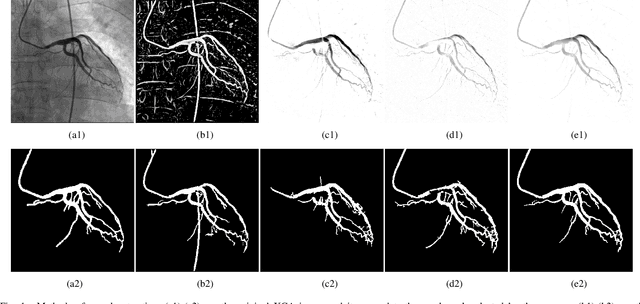
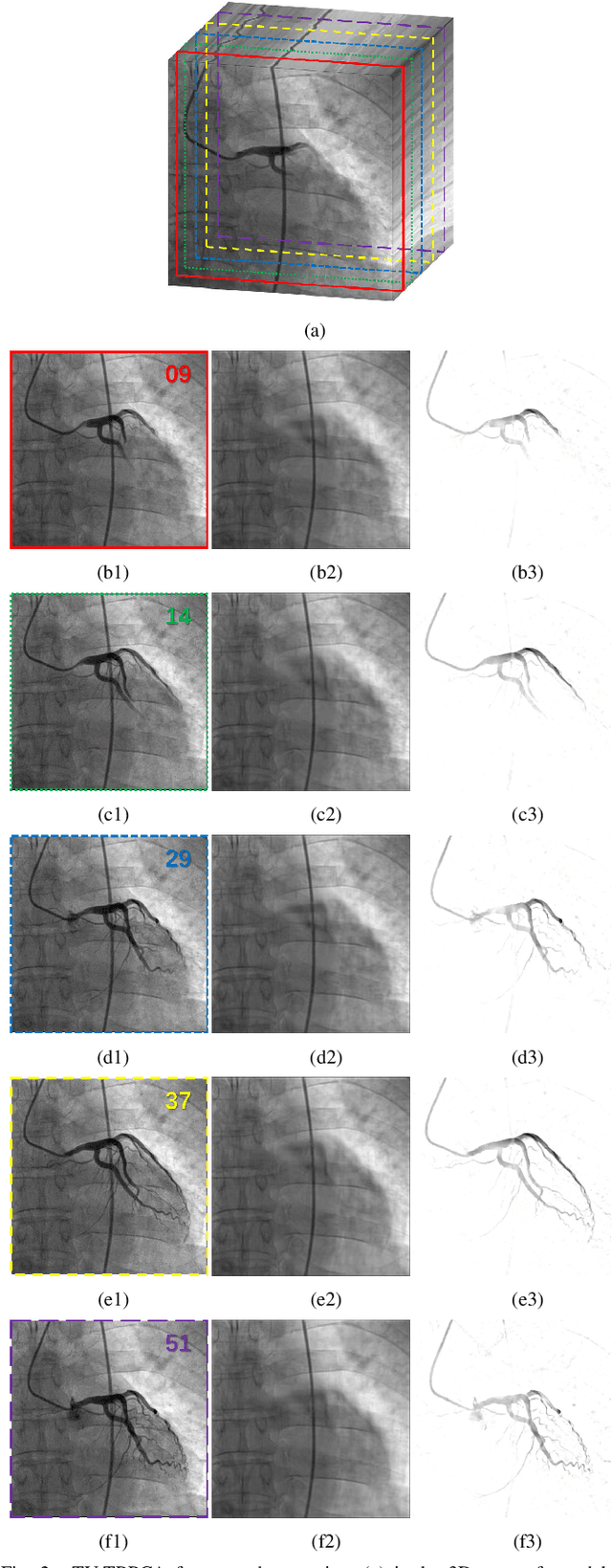
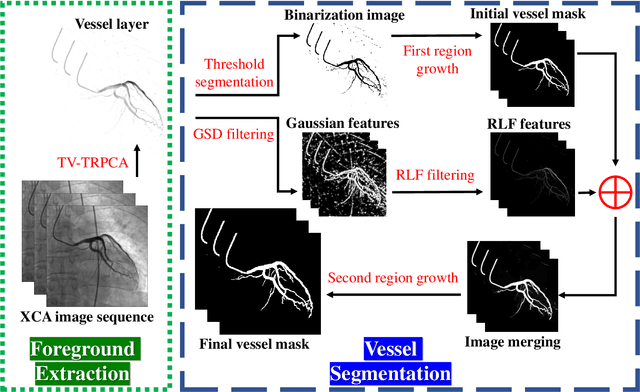
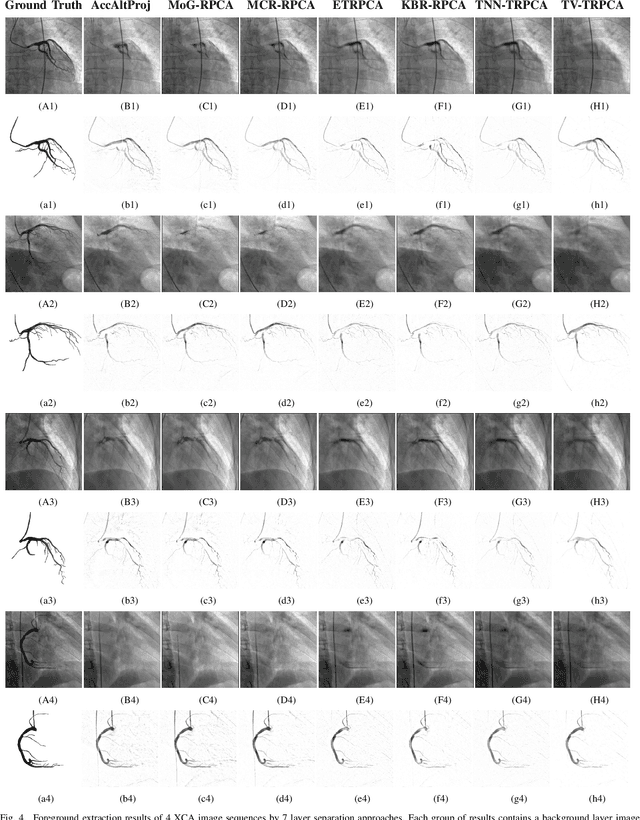
Abstract:The extraction of contrast-filled vessels from X-ray coronary angiography(XCA) image sequence has important clinical significance for intuitively diagnosis and therapy. In this study, XCA image sequence O is regarded as a three-dimensional tensor input, vessel layer H is a sparse tensor, and background layer B is a low-rank tensor. Using tensor nuclear norm(TNN) minimization, a novel method for vessel layer extraction based on tensor robust principal component analysis(TRPCA) is proposed. Furthermore, considering the irregular movement of vessels and the dynamic interference of surrounding irrelevant tissues, the total variation(TV) regularized spatial-temporal constraint is introduced to separate the dynamic background E. Subsequently, for the vessel images with uneven contrast distribution, a two-stage region growth(TSRG) method is utilized for vessel enhancement and segmentation. A global threshold segmentation is used as the pre-processing to obtain the main branch, and the Radon-Like features(RLF) filter is used to enhance and connect broken minor segments, the final vessel mask is constructed by combining the two intermediate results. We evaluated the visibility of TV-TRPCA algorithm for foreground extraction and the accuracy of TSRG algorithm for vessel segmentation on real clinical XCA image sequences and third-party database. Both qualitative and quantitative results verify the superiority of the proposed methods over the existing state-of-the-art approaches.
Anatomy-Aware Contrastive Representation Learning for Fetal Ultrasound
Aug 22, 2022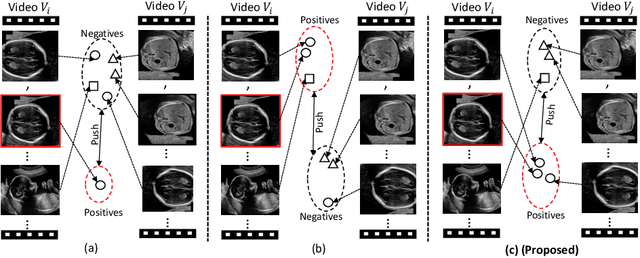

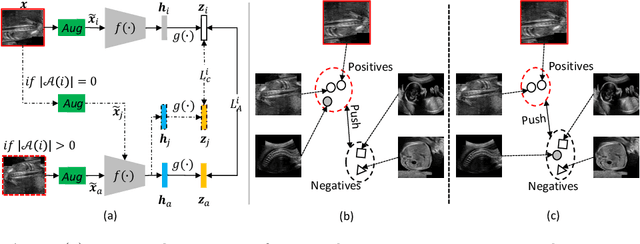
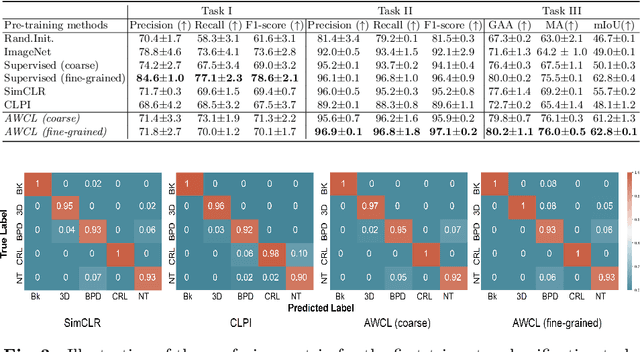
Abstract:Self-supervised contrastive representation learning offers the advantage of learning meaningful visual representations from unlabeled medical datasets for transfer learning. However, applying current contrastive learning approaches to medical data without considering its domain-specific anatomical characteristics may lead to visual representations that are inconsistent in appearance and semantics. In this paper, we propose to improve visual representations of medical images via anatomy-aware contrastive learning (AWCL), which incorporates anatomy information to augment the positive/negative pair sampling in a contrastive learning manner. The proposed approach is demonstrated for automated fetal ultrasound imaging tasks, enabling the positive pairs from the same or different ultrasound scans that are anatomically similar to be pulled together and thus improving the representation learning. We empirically investigate the effect of inclusion of anatomy information with coarse- and fine-grained granularity, for contrastive learning and find that learning with fine-grained anatomy information which preserves intra-class difference is more effective than its counterpart. We also analyze the impact of anatomy ratio on our AWCL framework and find that using more distinct but anatomically similar samples to compose positive pairs results in better quality representations. Experiments on a large-scale fetal ultrasound dataset demonstrate that our approach is effective for learning representations that transfer well to three clinical downstream tasks, and achieves superior performance compared to ImageNet supervised and the current state-of-the-art contrastive learning methods. In particular, AWCL outperforms ImageNet supervised method by 13.8% and state-of-the-art contrastive-based method by 7.1% on a cross-domain segmentation task.
Facial Anatomical Landmark Detection using Regularized Transfer Learning with Application to Fetal Alcohol Syndrome Recognition
Sep 12, 2021
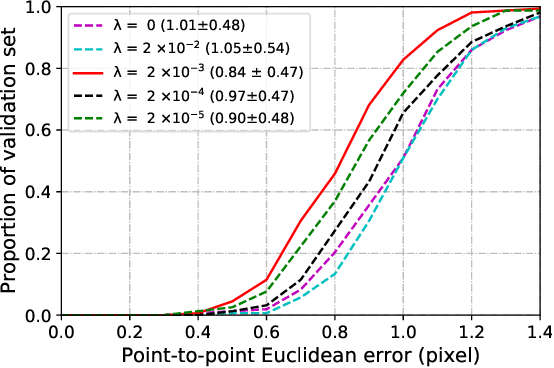
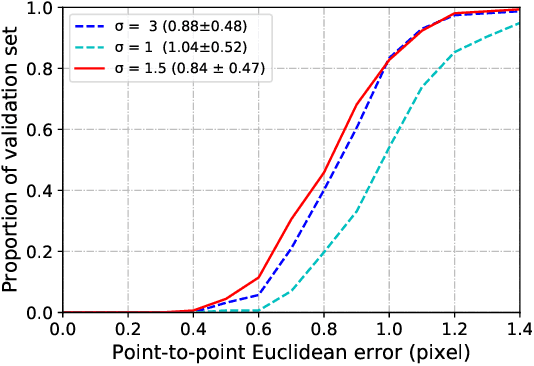

Abstract:Fetal alcohol syndrome (FAS) caused by prenatal alcohol exposure can result in a series of cranio-facial anomalies, and behavioral and neurocognitive problems. Current diagnosis of FAS is typically done by identifying a set of facial characteristics, which are often obtained by manual examination. Anatomical landmark detection, which provides rich geometric information, is important to detect the presence of FAS associated facial anomalies. This imaging application is characterized by large variations in data appearance and limited availability of labeled data. Current deep learning-based heatmap regression methods designed for facial landmark detection in natural images assume availability of large datasets and are therefore not wellsuited for this application. To address this restriction, we develop a new regularized transfer learning approach that exploits the knowledge of a network learned on large facial recognition datasets. In contrast to standard transfer learning which focuses on adjusting the pre-trained weights, the proposed learning approach regularizes the model behavior. It explicitly reuses the rich visual semantics of a domain-similar source model on the target task data as an additional supervisory signal for regularizing landmark detection optimization. Specifically, we develop four regularization constraints for the proposed transfer learning, including constraining the feature outputs from classification and intermediate layers, as well as matching activation attention maps in both spatial and channel levels. Experimental evaluation on a collected clinical imaging dataset demonstrate that the proposed approach can effectively improve model generalizability under limited training samples, and is advantageous to other approaches in the literature.
Cross-Task Representation Learning for Anatomical Landmark Detection
Sep 28, 2020



Abstract:Recently, there is an increasing demand for automatically detecting anatomical landmarks which provide rich structural information to facilitate subsequent medical image analysis. Current methods related to this task often leverage the power of deep neural networks, while a major challenge in fine tuning such models in medical applications arises from insufficient number of labeled samples. To address this, we propose to regularize the knowledge transfer across source and target tasks through cross-task representation learning. The proposed method is demonstrated for extracting facial anatomical landmarks which facilitate the diagnosis of fetal alcohol syndrome. The source and target tasks in this work are face recognition and landmark detection, respectively. The main idea of the proposed method is to retain the feature representations of the source model on the target task data, and to leverage them as an additional source of supervisory signals for regularizing the target model learning, thereby improving its performance under limited training samples. Concretely, we present two approaches for the proposed representation learning by constraining either final or intermediate model features on the target model. Experimental results on a clinical face image dataset demonstrate that the proposed approach works well with few labeled data, and outperforms other compared approaches.
MPG-Net: Multi-Prediction Guided Network for Segmentation of Retinal Layers in OCT Images
Sep 28, 2020


Abstract:Optical coherence tomography (OCT) is a commonly-used method of extracting high resolution retinal information. Moreover there is an increasing demand for the automated retinal layer segmentation which facilitates the retinal disease diagnosis. In this paper, we propose a novel multiprediction guided attention network (MPG-Net) for automated retinal layer segmentation in OCT images. The proposed method consists of two major steps to strengthen the discriminative power of a U-shape Fully convolutional network (FCN) for reliable automated segmentation. Firstly, the feature refinement module which adaptively re-weights the feature channels is exploited in the encoder to capture more informative features and discard information in irrelevant regions. Furthermore, we propose a multi-prediction guided attention mechanism which provides pixel-wise semantic prediction guidance to better recover the segmentation mask at each scale. This mechanism which transforms the deep supervision to supervised attention is able to guide feature aggregation with more semantic information between intermediate layers. Experiments on the publicly available Duke OCT dataset confirm the effectiveness of the proposed method as well as an improved performance over other state-of-the-art approaches.
 Add to Chrome
Add to Chrome Add to Firefox
Add to Firefox Add to Edge
Add to Edge